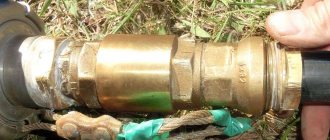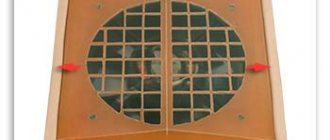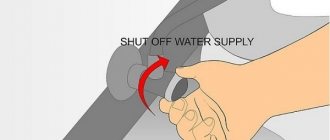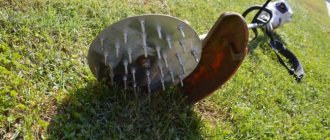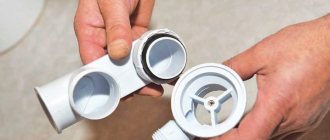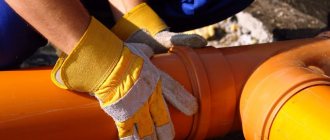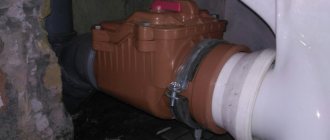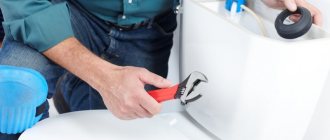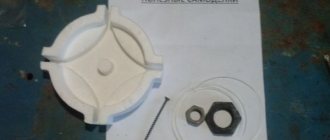A check valve is a device through which water flow can only be directed in one direction. Works completely autonomously, without the need to connect a power supply. Used in water supply and heating systems. Additionally protects the water supply from breakdowns in emergency situations.
You can clearly see the design of the device and its varieties in the photo of a water check valve. Valves are available in different sizes and shapes, depending on their application and function.
Purpose of the device
The water back pressure valve is designed to prevent water flow from being directed in the other direction. It has small dimensions and provides the necessary pressure in the pipeline.
Used for the following purposes:
In the water supply system. Installed on cold and hot water pipes in apartment buildings and private buildings. Normalizes the pressure in the system, providing the possibility of comfortable mixing of water and adjusting its temperature with a mixer.
In water heating systems. Boiler-type water heaters are filled with water under pressure. As the water heats up and increases, the flow tends back into the cold pipe. The check valve prevents water from being pushed back into the pipe.
In heating systems. Installed if the system consists of several circuits (water heater, heated floor, radiators), in which the flow parameters differ, to normalize the pressure.
In front of the counter. To protect the meter from failure due to pressure surges.
In water well systems powered by submersible pumps. Eliminates the possibility of water backflow after turning off the pump.
Classification of fittings according to the method of sealing to the external environment
Stuffing box fittings. The tightness of the fittings in relation to the external environment is ensured by the stuffing box, which is in constant contact with the moving element of the fittings - the spindle, which performs a reciprocating movement during operation. The collapsible stuffing box assembly is used in gate valves, taps, and valves. The exception is imported pipeline fittings from Naval, Danfoss, Jafar, where one or more O-rings are used to ensure tightness.
Bellows fittings. The tightness of the fittings is ensured by a bellows assembly, which is a corrugated pipe made of stainless steel or special plastic. Under load, the bellows is deformed, but retains its properties, ensuring tightness both in the valve and in relation to the external environment. Bellows units are used in shut-off valves, RDS pressure regulators, SPPK safety valves and other fittings.
Membrane fittings. The design of the valve includes an elastic element - a membrane, which performs the function of a valve, a sealing element of the valve and a body seal. This design is used in diaphragm valves (solenoid, solenoid) in shut-off and safety valves. Also, the membrane is often used as a sensitive element in water or steam pressure regulators.
Hose fittings. Fittings in which the flow of the working medium is blocked by pinching an elastic hose are called hose fittings. The elastomer ensures tightness in relation to the external environment and is a locking organ. Hose valves are often used for liquid, viscous and aggressive media, because... have excellent tightness and zero hydraulic resistance.
Principle of operation
The valve has a spring-loaded shutter. When water stops flowing, the spring changes the position of the valve, blocking the pipeline. When a flow of water is applied under pressure, the spring is weakened, as a result of which the pipeline opens.
After the pump is turned off, the pressure in the system drops. Installing a check valve on the water in this case allows you to completely stop the flow.
In addition to the spring, the shutter mechanism is additionally pressed by the water flow, which eliminates the possibility of spontaneous opening of the pipeline.
Main tasks of the device
It stabilizes the pressure in the system, protects against water hammer, and prevents reverse fluid circulation. If the valve is installed in a submersible pump in front of a well in a summer cottage, it allows the pump to operate without failures or breakdowns.
Varieties
In stores where you can buy a check valve for water, various types of such devices are presented. They have a fairly simple design, including a body, a clamping mechanism and a locking part.
Based on the model, additional elements may be present: a rod, a hinge pin, a ball, a bearing, etc. The price of a check valve for water depends on its size, water flow parameters, materials used and additional parts.
Depending on the type of shut-off part, the following types of valves can be distinguished:
- turning. There is a rotary metal disk installed inside, which, when rotated, blocks or opens the flow;
- ball. A spherical spool is used inside;
- lifting. The locking element is a movable valve. Such a valve can only be mounted on vertical pipes;
- disk. The pressure is blocked by a disk with a clamping mechanism.
Based on the type of fastening, there are the following valves:
- threaded;
- wafer;
- flanged;
- for installation by welding.
Classification of reinforcement depending on design
A gate valve is a shut-off valve in which the shut-off element is located vertically, at an angle of 90 degrees, to the center line of the main pipes. Valves made of cast iron or steel, in which the shut-off element is made in the form of a wedge, are called wedge valves. There are also hose valves, the design of which includes an elastic hose, which, when pinched, ensures shutoff of the transported medium. As well as knife gate valves designed for installation on viscous and pulp-like media.
A valve is a pipeline fitting in which the locking (regulating) element has a disk shape. Butterfly valves have a flange or wafer (compression) connection to the pipeline. Steel butterfly valves (shut-off or check valves) can have welding connections. The advantages of the valves are low weight and low hydraulic resistance.
A valve (valve) is a pipeline fitting in which a locking or regulating disc element is located horizontally or at an angle (direct flow valves) to the center line of the main pipes. Structurally, a distinction is made between membrane valves, in which an elastic membrane is used as a shut-off element (direct and indirect acting electromagnetic valves). The diaphragm in such valves serves as a shut-off element, a seal of the shut-off element and a sealed body ring. The design of the regulator (control valve) is a valve with a control device (drive) installed on it.
A valve is a pipeline fitting in which the main element has a conical or cylindrical shape and rotates at an angle of 90 degrees (plug-gland valve) or at an angle of 180 degrees (three-way valve). Ball valve is a pipeline fitting in which the shut-off or control element has a ball (spherical) shape. In addition to shut-off valves, there are regulating ball valves, for example, Naval trim, Vexve. In control valves, the ball has a special design designed to change (regulate) the flow of the working medium.
Check valve installation
A water check valve usually has a coupling design. This is the most popular variety. This valve is suitable for water supply and heating systems.
To install you need to follow a few simple steps:
- decide on the installation location. Usually installed in front of a meter or heating boiler;
- a sealant (FUM tape and the like) is wound onto the threaded sections of the fittings;
- the valve is secured with fittings. After installation, you need to check the system for leaks.
The valve always has an arrow indicating the direction of water flow. Be sure to mount the device in the appropriate direction. Otherwise, the valve will block the flow of water.
Pump for a summer residence: types, description of modern models, selection criteria and main parameters of the pump (125 photos)- World Print Company
Insulation of pipes - tips for choosing the optimal materials and methods for insulating water pipes (115 photos)
There are special valve models designed for sewer systems. They prevent waste and runoff from flowing back into the pipe.
Installation is carried out by inserting into the pipeline. The diameter of such valves can vary from 50 to 100 mm.
Classification of fittings according to installation method
Coupling fittings. Mounted using couplings (internal pipe, conical, cylindrical or other threads). These are mainly ball valves, cast iron valves, valves of small diameters, DN up to 50 mm (in rare cases up to 80 mm). It is used on household sanitary fittings, special and control fittings.
Pin fittings. Mounted into the pipeline system using an external thread, with a collar for an O-ring. It is used on special high-pressure fittings, on pipelines with an aggressive working environment and in cases where it is necessary to ensure high reliability and quick release of the connection.
Fittings are fittings. Mounted to the pipeline using pipes with external threads. The mating part of the pipeline is called a fitting or nipple (with internal thread). Used on some types of ball valves, valves, American-type connections and special (control) fittings.
Welding fittings. Mounted to the pipeline using welded fittings. This is the most reliable type of connection. Mainly used on energy gate valves and high pressure valves. Also, welding connections are widely used on ball valves, domestic and imported pipeline fittings.
Flange fittings. Mounted to the pipeline using flanges, in accordance with GOST 12815-80. The majority of cast iron and steel valves are manufactured with flange connections. Convenient installation and the ability to quickly replace equipment on the pipeline allow this type of connection to be used in most cases. In addition to gate valves, flange connections are used on butterfly valves, valves, taps, and when installing fittings and fire-fighting equipment in the city water supply network.
Tightening fittings. The wafer (pinch) connection is widely used for mounting butterfly valves, gate valves, some types of check valves and regulators. The coupling fittings do not have their own connecting flanges and are tightened with studs between the flanges installed on the pipeline. The advantage of wafer fittings is the reliability of the connection and low weight.
Types of sewer shut-off valves
The operating principle of a sewer check valve is based on blocking the flow of liquid flowing in the opposite direction. A movable barrier is mounted inside the device, which performs the main function of the valve.
The equipment differs according to the type of barrier and the nature of the work:
- Reed (rotary) valves have a spring-loaded circular diaphragm. When the drains move in the desired direction, it rises; otherwise, it simply presses against the rim of the valve, blocking the flow of the drains.
- The lift check valve gets its name from its operating principle. The principle of operation of the check valve is simple: under the pressure of the waste, the membrane simply rises up, opening the passage. If there are no drains, the passage is closed, and if the liquid flows in the opposite direction, then it is impossible to open the passage due to the special nonlinear shape of the housing. The reliability of such a valve is very high, but it often becomes clogged, so regular cleaning is required.
- The operating principle of a ball-type check valve is based on the movement of a special ball inside the body. In such a device, the main role is played by the structure of the body. Under the pressure of the drains, the ball opens the passage.
- Wafer check valve is widely used due to its small size. By design, it is a small cylinder, inside of which a rotary valve is mounted. True, it is rarely used in sewer systems, since it is very difficult to clean - you have to disassemble the entire body.
